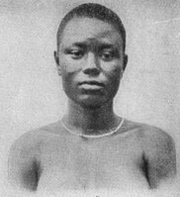Porto-Novo
2008/9 Schools Wikipedia Selection. Related subjects: Africa; Cities
| Porto-Novo Hogbonou, Adjacé |
|
| Location of Porto-Novo in Benin | |
| Coordinates: | |
|---|---|
| Country | Benin |
| Established | 16th century |
| Population (2002) | |
| - Total | 223,552 |
Porto-Novo (also known as Hogbonou and Adjacé (population 223,552 as of a 2002 census) is the official capital of the West African nation of Benin. It is a port on an inlet of the Gulf of Guinea, in the southeastern portion of the country. Porto-Novo is Benin's second largest city, but the city of Cotonou is more important, culturally and politically. The region around Porto-Novo produces palm oil, cotton and kapok. Petroleum was discovered off the coast of the city in the 1990s, and has become an important export.
Porto-Novo is located at 6°28' North, 2°36' East (6.46667, 2.6).
History
Porto-Novo was probably founded in the late 16th century by the legendary King Te-Agdanlin of Allada. The city received its name from the Portuguese for "New Port." It was originally developed as a port for the slave trade.
In 1863, the British, who were active in nearby Nigeria, bombarded the city, which convinced the Kingdom of Porto-Novo to accept French "protection." The neighboring Kingdom of Abomey objected to French involvement in the region, and war broke out between the two states. In 1883, Porto-Novo was incorporated into the French "colony of Dahomey and its dependencies". In 1900 it became Dahomey's capital city.
The Kings of Porto-Novo continued to rule in the city, both officially and unofficially, until the death of the last King, Alohinto Gbeffa, in 1976. From 1908, they were known as the Chef supérieur.
Many Afro-Brazilians settled in Porto-Novo following their return to Africa after emancipation from slavery in Brazil. Brazilian architecture and foods have become important in the city's cultural life.
Demographics
Porto Novo had a population of 234,168 (2005 estimates).
Population Development:
- 1979: 133.168 (Census)
- 1992: 179.138 (Census)
- 2000: 210.400 (Estimate)
- 2002: 223.552 (Estimate)
- 2005: 234.168 (Estimate)
Things to see
- The Porto Novo Museum of Ethnography contains a large collection of Yoruba masks, as well as items on the history of the city and of Benin.
- King Toffa's palace (also known as the Musée Honmé and the Royal Palace), now a museum, shows what life was like for African royalty.
- Jardin Place Jean Bayol is a large plaza which contains a statue of the first King of Porto-Novo.
- The da Silva Museum is a museum of Benin history. It shows what life was like for the returning Afro-Brazilians
- The palais de Governor (governor's palace) is the home of the national legislature.
Other sites of interest include a Brazilian-style church, which is now a mosque, and the Institute of Higher Studies of Benin. Stade Municipale and Stade Charles de Gaulle, or Charles de Gaulle Stadium, are the largest football stadiums in the city.
Porto-Novo is not far from the cultural and historical living history town of Ouidah. It is also near to Nigeria and to Cotonou, and is not far from Pendjari National Park, a natural habitat for many African animal species.
Adjogan
Adjogan music is endemic to Porto-Novo. The style of music is played on an alounloun, a stick with metallic rings attached which jingle in time with the beating of the stick. The alounloun is said to descend from the staff of office of King Te-Agdanlin. The music is played to honour the King and his ministers. The music is also played in the city's Roman Catholic churches, but the royal bird crest has been replaced with a cross.

